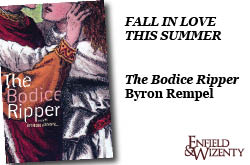 Reviewed by Hubert O’Hearn from uncorrected proof
Reviewed by Hubert O’Hearn from uncorrected proof
“No, you’re not. A police station is no place for a young girl. Isn’t that right, Constable?”
“Oh, we get plenty of young women, sir, and our new station house has some of the most modern facilities in Canada to keep them while they wait their turn with the magistrate.”
“You see, Charles. Mrs. Doolittle says that women need to see what’s really happening in the world; not be shielded from the least unpleasantness.”
So upon reading the above quote, what do you, the astute reader of mysteries, deduce? If your assumption is that Put on the Armour of Light is a period piece and has a strong taste of early feminism, well done. You receive full marks.
In what is rather a delicious coincidence, the most recent mystery novel I read and reviewed also had a feminist slant to it. That was Last Kiss by Ireland’s award-winning Louise Phillips. Phillips’ lead character, a woman psychologist, also faces barriers placed against her by the mucho macho realm of the Dublin constabulary. In Catherine Macdonald’s novel, her best and most fully realized character is Rosetta Cliffe, a photographer. I’ll get back to the comparison test shortly.
As Put on the Armour of Light is set in 1890s Winnipeg, Cliffe not only has to do her work against the chauvinistic current, she also has to prove the validity of her very technique. Given the sheer bulk of early cameras, they were seen as clunky obtrusions in a crime scene. However, one constable realizes that a photograph taken of an important piece of evidence – a button, in case you’re interested – could be used for the investigation and so allowed for greater efficiency. Multiple investigators could take the photographs around to multiple tailors rather than just toting the actual fastener and, well you get the picture. Ahem.
As to that crime scene, a prominent businessman is found dead in his office. Also found in the office is that button, and an extremely drunk gambler who was owed money by the deceased. The drunk, Peter McEvoy, was so drunk that he can barely remember a thing, although he doesn’t think he is the murderer. McEvoy is also, in an absolutely not at all incredible coincidence, is also the former college roommate of a local Presbyterian Minister. That Minister, Charles Lauchlan, is also somewhat enamoured with Maggie, who is also being pursued by one Trevor Martland, whose father was the business partner of the deceased. Complications arise.
It would be, er, criminal to go into any further detail on the plot. Let me just say that the investigation proceeds smoothly with the unexpected twists and shocking revelations that one expects from the genre. Murder mysteries have the exact same appeal as cryptic crosswords: the fun is in solving the clues.
So how’s the book? Any police procedural set in nineteenth century Canada cannot help but be compared to Maureen Jennings’ Murdoch mysteries. Where I would give Jennings the edge is in the sheer richness of detail, which Put on the Armour of Light lacks. Here is an example of what I mean. “Charles made an effort not to remember various texts he had quoted from the pulpit as he looked at Peter, who now sat miserably with his head bowed.” Um, why? And more to the point, which texts were they? I don’t wish to sound harsh, but when I read that line I had a sneaking suspicion that Macdonald wanted to avoid digging through a Bible to choose a few verses, whereas if she had done just that, the scene would have been ever so much richer.
Here is another passage, which handily summarizes why Put on the Armour of Light is no Last Kiss. In the same scene as above, Charles sees his old roomie for the first time in fifteen years, in the police station lock-up:
Charles gripped Peter by one elbow, grabbed his hand, and gave it a thorough shaking. “Pete, for goodness’ sake! After all this time — it must be fifteen years. Why didn’t you write? I tried and tried to find you but nobody had a blessed idea where you were.” Behind this bonhomie, Charles was fighting an urgent desire to get out — down the hall, up the stairs, out the door, and into the sweet evening air.
Wait. None of this makes sense. Ask yourself, if you were in this situation as Charles, would bonhomie describe you emotionally? And, would you really be impatient to immediately want to leave? Mere curiosity would compel most people to want to stick around, particularly as it is established that Charles’s ministry is devoted to the down-and-out.
The great crime novelists like Louise Phillips know that even in a genre similar to crosswords, all the words and actions must have a true logic to them. Charles’s urgent desire for sweet evening air makes for a pretty sentence, however if I may paraphrase something said during a very famous murder trial, “If the logic don’t fit, you must omit.”
The strength of Macdonald’s novel is in the social milieu. That she gets quite correctly. I enjoyed, if that’s the correct word, the whispered racism holding back the career of a Métis police officer. The feminist sub-plot is equally appealing
Ultimately, Put on the Armour of Light is a good book. If you like murder mysteries, you’ll have a fine time with it. However, it does not fit into the top rank of the genre.
Dundurn| 288 pages | $17.99 | paper | ISBN # 978-1459715493





One Comment
Good book! Enjoyed the “old Winnipeg” locales and references. Thanks, Owen.